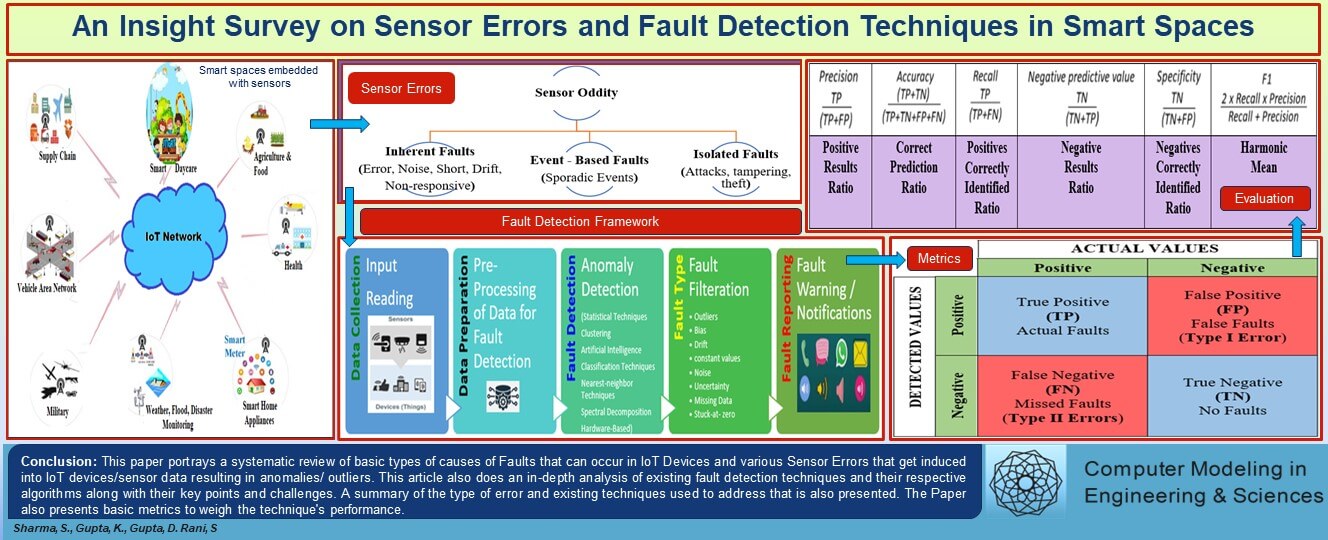 Open Access
Open Access
REVIEW
An Insight Survey on Sensor Errors and Fault Detection Techniques in Smart Spaces
1 Chitkara University Institute of Engineering and Technology, Chitkara University, Punjab, 140401, India
2 PG Department of Information Technology, Goswami Ganesh Dutta Sanatan Dharma College, Chandigarh, 160030, India
3 Department of Computer Science, Government Bikram College of Commerce, Patiala, India
4 Department of Electrical and Computer Engineering, Lebanese American University, Byblos, Lebanon
5 University Centre for Research and Development, Department of Computer Science and Engineering, Chandigarh University, Mohali, 140413, India
6 Department of Computer Science and Engineering, Graphic Era Deemed to be University, Dehradun, 248002, India
7 Division of Research and Development, Lovely Professional University, Punjab, 144001, India
* Corresponding Authors: Shalli Rani. Email: ; Gaurav Dhiman. Email:
Computer Modeling in Engineering & Sciences 2024, 138(3), 2029-2059. https://doi.org/10.32604/cmes.2023.029997
Received 17 March 2023; Accepted 10 August 2023; Issue published 15 December 2023
Abstract
The widespread adoption of the Internet of Things (IoT) has transformed various sectors globally, making them more intelligent and connected. However, this advancement comes with challenges related to the effectiveness of IoT devices. These devices, present in offices, homes, industries, and more, need constant monitoring to ensure their proper functionality. The success of smart systems relies on their seamless operation and ability to handle faults. Sensors, crucial components of these systems, gather data and contribute to their functionality. Therefore, sensor faults can compromise the system’s reliability and undermine the trustworthiness of smart environments. To address these concerns, various techniques and algorithms can be employed to enhance the performance of IoT devices through effective fault detection. This paper conducted a thorough review of the existing literature and conducted a detailed analysis. This analysis effectively links sensor errors with a prominent fault detection technique capable of addressing them. This study is innovative because it paves the way for future researchers to explore errors that have not yet been tackled by existing fault detection methods. Significant, the paper, also highlights essential factors for selecting and adopting fault detection techniques, as well as the characteristics of datasets and their corresponding recommended techniques. Additionally, the paper presents a methodical overview of fault detection techniques employed in smart devices, including the metrics used for evaluation. Furthermore, the paper examines the body of academic work related to sensor faults and fault detection techniques within the domain. This reflects the growing inclination and scholarly attention of researchers and academicians toward strategies for fault detection within the realm of the Internet of Things.Graphic Abstract

Keywords
Cite This Article
 Copyright © 2024 The Author(s). Published by Tech Science Press.
Copyright © 2024 The Author(s). Published by Tech Science Press.This work is licensed under a Creative Commons Attribution 4.0 International License , which permits unrestricted use, distribution, and reproduction in any medium, provided the original work is properly cited.


 Submit a Paper
Submit a Paper Propose a Special lssue
Propose a Special lssue View Full Text
View Full Text Download PDF
Download PDF Downloads
Downloads
 Citation Tools
Citation Tools
